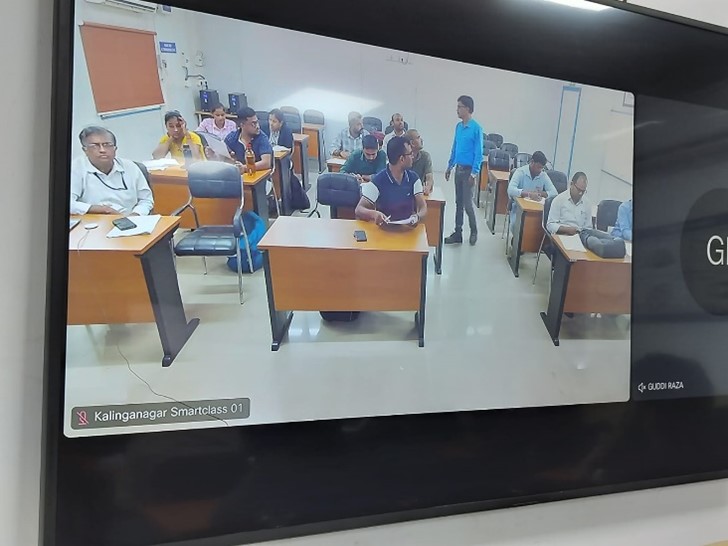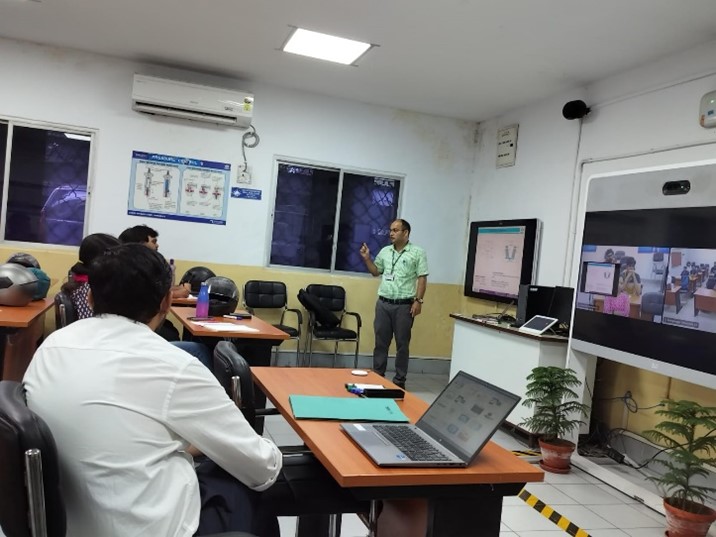Water is a material issue for Tata Steel. The Company proactively identifies, assesses, and monitors water-related risks through its Enterprise Risk Management framework. It then develops action plans to mitigate these risks. This framework is crucial for building business resilience in a volatile and complex world, especially in the face of changing climate and land use patterns.
Tata Steel aspires to reduce its specific freshwater consumption below 1.5 m3/tcs (cubic metres per tonne of crude steel) across all sites by 2030 and to achieve Zero Effluent Discharge (ZED). The Company also aims to replenish more water than it withdraws. Tata Steel firmly promotes the 4R framework (Reduce, Recycle, Reuse and Replenish) as a key driver for reducing freshwater consumption and effluent generation. Tata Steel is exploring and investing in novel technologies that help achieve a low water footprint for all its upcoming new facilities for sustainable growth. Where feasible, wet processes are converted to dry processes such as coke quenching and gas cleaning plants. A fraction of the effluents is utilised in low-end applications like slag quenching and dust suppressions, with the majority recycled in ETPs (Effluent Treatment Plants). The ETPs are equipped with ultrafiltration and reverse osmosis technologies for increased recycling and crystallisers with multiple effect evaporators are installed to enable zero effluent discharge. Tata Steel also reuses the treated municipal sewage for its operations and plans to increase its utilisation.
Tata Steel conducted River Basin studies at its major operating locations to understand the use pattern of the shared resources, like land, rainfall, deforestation, assessment of impacts on local stakeholders, future water quality-related risks, future potential regulatory changes at a regional level and population to ascertain the water stewardship for the organisation. A River Basin study for the primary water sources in water stress areas like the Subarnarekha River in the Jharkhand province was done, followed by another for the Brahmani River in 2023.
Tata Steel continuously monitors its water efficiency, withdrawals, discharge, and consumption with real-time monitoring and early warning indicators. The reported figures are audited and validated through a third-party assurance. The audit scope includes withdrawal and discharge quantity and quality. For the reporting year, the total water intensity in terms of physical output is 4.1 m3/tcs. The organisation self-assesses its water efficiency by tracking its specific water consumption and effluent discharge intensity in the financial year. The organisation's water efficiency is reviewed at various levels including the apex level comprising of Board members. Dedicate technology leadership area (TLA) for water has been established to take the challenges related to water management and chalk out the solutions through Research & Development. A dedicated wing of team named ‘Innoventure’ is responsible for exploring solutions for water-related challenges through startups and small businesses.
Regulatory and Reputational Risk Associated with Water
The regulatory bodies have framed strict laws related to water allocation for organisations' operations. Organisations can withdraw water to a limit as per the agreement with governments. The water allocation laws are anticipated to grow more stringent with increased penalties and consequences along with restrictions on water withdrawal during the lean period.
To mitigate the risk, Tata Steel strives to reduce its dependency on natural resources by increasing the use of treated municipal sewage or industrial effluent. The effluent to be discharged from the works must be within the permissible quality limits for pH, Total Dissolved Solids, Ammoniacal Nitrogen, Oil and grease, Biological Oxygen Demand (BOD), Chemical Oxygen Demand (COD), Total Cyanide, etc. The permissible limits vary with the operation's locations. The Company focuses on recycling and treating the generated effluent through ETPs to mitigate the discharge. Multiple Tata Steel locations have achieved the ZED status, and more will be added to the list in this financial year.
Initiatives to Utilise Wastewater
Tata Steel also focuses on the improvement of wastewater quality to utilise it in its process:
- It has installed a state-of-the-art Central Effluent Treatment Plant (CETP) at its Jamshedpur works of 9 mgd (million gallons per day) capacity. The CETP is equipped with membrane technology to reduce the total dissolved solids in the water. The treated water is utilised in the operational process.
- Another is being planned for the Company's Meramandali site. The treatment unit will treat the coke oven effluent and the effluent with high dissolved solids.
- A brand-new installation is under way at Jamshedpur for the tertiary treatment of the coke oven effluent. This new unit will use membrane technology, a crystalliser, and an evaporator. The treated effluent will be low in dissolved solids and used in the operations.
- Tata Steel has also installed a CETP equipped with membrane technology and crystalliser and evaporator units at its Kalinganagar unit to ensure no effluent discharge.
- M/s Ecolab conducted a comprehensive study at Jamshedpur Works for a water efficiency plan which provides many interventions to reduce the plant's water footprint.
Creating Awareness
Tata Steel conducts regular awareness training for its employees on water efficiency management programmes throughout the year, both physically and online. A dedicated course on Water Management has been launched in the School of Excellence. This initiative is designed to educate employees on water treatment technologies and process (including general information about water treatment chemicals), water efficiency management programs, benefit of rainwater harvesting, design of rainwater harvesting structures, water assessment methodologies the scarcity/stress of freshwater, and some advanced technologies for effluent treatment. The course outlines a general introduction to water, The programme provides relevant information and knowledge to every employee to inculcate sensitivity towards water and its utilisation.
Water risk and efficiency management have become vital elements of any sustainable business plan. Tata Steel prioritises water efficiency and security by conducting thorough planning and research to ensure its operations are safe and to further the cause of water sustainability.
By building internal capacity and awareness, we empower our workforce to contribute meaningfully to our water sustainability goals.
Water Efficiency Management at Tata Steel
At Tata Steel, we are committed to sustainable water management across all our operations. In alignment with our goal to lead in sustainable steel manufacturing, we have implemented a robust water efficiency framework that includes:
1. Water Use Assessment and Benchmarking
We systematically measure and monitor water consumption across all the steel manufacturing processes throughout the locations. This granular approach enables us to benchmark water usage process-wise, identify inefficiencies, and implement targeted improvements. Flowmeters are installed at every consumption point and are periodically calibrated by certified third-party vendors, ensuring accuracy and reliability. Calibration certificates are maintained as part of our compliance and audit processes.
Water audits are conducted periodically which aims to identify areas of inefficiency or wastage and recommend strategies for conservation and cost reduction. Through these rigorous activities we have identified some key areas of improvement in the processes which demands technical innovation to reduce the water footprint of the process. Conversion of wet processes to dry processes, like implementation of Coke dry quenching, Dry Gas cleaning Plant, Air cooled condensers for power plant, Adiabatic coolers/cooling towers, etc.
2. Water Recycling and Zero Effluent Discharge (ZED)
Tata Steel is actively working towards achieving Zero Effluent Discharge at its major steel manufacturing facilities in Odisha and Jharkhand. Through ZED, process effluents are treated and reused within operations, significantly reducing the dependency on freshwater sources. This initiative not only minimizes our water footprint but also reinforces our commitment to circular water use and environmental stewardship.
 Corporate
Corporate
 Sustainability
Sustainability
 Products & Solutions
Products & Solutions
 Investors
Investors
 Careers
Careers
 Contact Us
Contact Us







